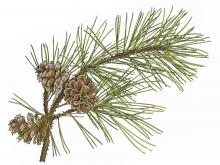Trees, Shrubs and Woody Vines
Media

Species Types
Scientific Name
Cercis canadensis
Description
Eastern redbud is a native shrub or small tree that is distinctly ornamental in spring with small, clustered, rose-purple flowers covering the bare branches before the leaves.
Media

Species Types
Scientific Name
Fraxinus americana
Description
White ash leaves turn shades of yellow and purple in fall, and that is one reason it has been a popular landscaping tree. Many birds and mammals feed on the paddle-shaped seeds.
Media

Species Types
Scientific Name
Pinus echinata
Description
Existing in thousands of acres of nearly pure stands, shortleaf pine was once the dominant tree in much of the Missouri Ozarks. Today, Missouri’s only native pine tree is recovering from the extensive logging that had exhausted its old-growth stands by the 1920s.
Species Types
Scientific Name
Tsuga canadensis
Description
Eastern, or Canadian hemlock is usually encountered only in landscaping in Missouri. But based on one instance in Oregon County, we know it can reproduce and spread here on its own. So if you find it on a hike, it was almost certainly planted there at some point. Look around for a cistern, old home foundation, and other persisting garden plants nearby.
Media

Species Types
Scientific Name
Juniperus virginiana
Description
By far the most common native conifer in the state, eastern red cedar is useful for its aromatic, red wood and beloved for its greenery, its resinous blue “berries,” and the spicy odor it lends the outdoors.
Media

Species Types
Scientific Name
Quercus alba
Description
Found throughout Missouri and in all kinds of habitats, the white oak is one of our most attractive, long-lived, and stately shade trees. Learn to recognize it by its light gray bark, rounded-lobed leaves, and distinctive acorns.
Media

Species Types
Scientific Name
Sassafras albidum
Description
Sassafras, with its aromatic oval, mitten- , and trident-shaped leaves, is rich in both human and natural history, and it can be a spectacular tree for fall color.
Media

Species Types
Scientific Name
Quercus macrocarpa
Description
Bur oaks can live for hundreds of years and become giants; many have legendary or historic status. As with most oak species, it can be identified by leaf shape.
Media

Species Types
Scientific Name
Elaeagnus umbellata
Description
Autumn olive can be found all over the state, since it was planted widely with the best of intentions. Despite its “pros,” this shrub has proven to be very invasive. It threatens native ecosystems and should not be planted.
Media

Species Types
Scientific Name
Lonicera maackii (Amur) and Lonicera x bella (bella)
Description
If there’s a giant green thicket in your woods, you may have a bush honeysuckle infestation. These invasive plants are shrubby natives of Asia. In America, where they have no natural controls, they leaf out early, grow fast, spread fast, and form dense thickets that crowd out native forest plants.
See Also
About Trees, Shrubs and Woody Vines in Missouri
There are no sharp dividing lines between trees, shrubs, and woody vines, or even between woody and nonwoody plants. “Wood” is a type of tissue made of cellulose and lignin that many plants develop as they mature — whether they are “woody” or not. Trees are woody plants over 13 feet tall with a single trunk. Shrubs are less than 13 feet tall, with multiple stems. Vines require support or else sprawl over the ground.





















